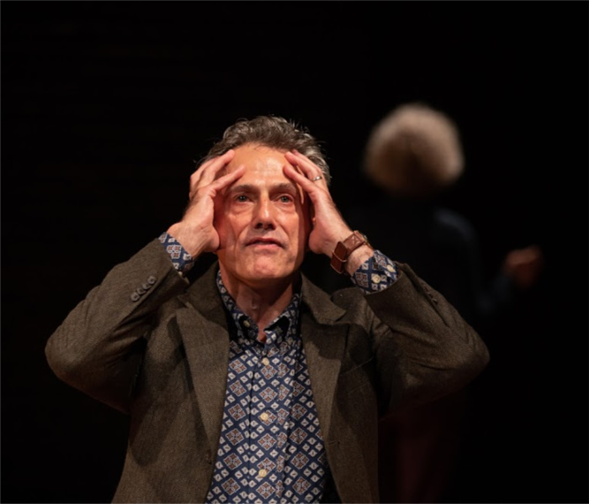Translate Page

Inside David Greenspan's new time- and reality-bending play
---
The spark for The Things That Were There was ignited the night David Greenspan agreed to auction off his talents. The five-time Obie winner -- who's as lauded for his performing as his playwriting -- was participating in New Dramatists' signature fundraiser Nocturnal Commissions, when scribes are sold to the highest bidder and, after a brief consultation with the winner, pen and premiere a playlet on the spot.
"I wrote about five pages and then I put it down," Greenspan recalls, but he kept picking it back up. Over time, the text evolved in what he calls "an ongoing revision." Instead of cutting out things he changed, he just added new parts on to them and "embraced that as the dramaturgy for the play."
The Things That Were There, currently playing at Brooklyn's Bushwick Starr in a coproduction with Abingdon Theatre Company, is a meditation on loss that hopscotches through time. Sequences are repeated with micro-shifts in language as a family relives various moments around a dinner table. "The focus of the play is the loss of a son -- their memories and their affection and their confusion about him," says Greenspan, who also appears in the show. "I wanted to write something that could change modalities. I kept pivoting back and forth, and I think that allows the audience to have a comic experience and a happy escape from the misery, and then the tragic experience of pathos."
The show's title is taken from a line in a Gertrude Stein lecture called Plays, which Greenspan previously performed on stage. He credits her writing as having an impact on his, though he explains, "it's less about imitating her or even being interested in her philosophy and aesthetics as it is by the breadth of her investigations into language and form and content."
Greenspan certainly experiments with all three of those elements in The Things That Were There. Multiple realities exist simultaneously and time bends, which feels truer to the lived experience of remembering than in a conventional memory play. It's telling that in the script, scenes aren't delineated with titles or headings because they don't have traditional start and endpoints. "Gertrude Stein talks about beginning again, scenes that just start up and are a little different," Greenspan says. "I thought that was in keeping with the theme of the play -- new things keep happening even if people die. Things come to an end and then begin again."
The design of the production, which is directed by Lee Sunday Evans, is spare so that the spotlight remains on the play and the players. "We have a dining room table with chairs but that's it," Greenspan says. "No props. I never use sound design in my plays. I like the natural voice. I'm not interested in visual effects. I don't like for things to be in the way. I like the audience having direct access to the actors so there's no amplification or fog."
That's typical for Greenspan, whose extensive credits as a performer run the gamut from last year's one-man interpretation of Eugene O'Neill's six-hour epic Strange Interlude, to understudying Edna Turnblad and her husband Wilbur in Broadway's Hairspray. Because of his experiences as an actor, when he writes plays he prefers to use words, not visuals, to activate a theatre audience's imagination. "In Henry V, 'Can this cockpit hold the vasty fields of France?' -- that evokes the whole thing," he says, quoting Shakespeare. "Or in Merchant of Venice there's that line: 'Look how the floor of heaven is thick inlaid with patens of bright gold.' You can't get a set better than that! He could paint the stage with words so that the audience could imagine and I think that's really valuable. In an image-driven culture, it's nice to go to the theatre and hear language and hear people talk."
---
Eliza Bent is a playwright, performer, and sometime pundit. Follow her on Instagram at @getbentobox. Follow TDF on Instagram at @tdfnyc.
Top image: David Greenspan in The Things That Were There. Photos by Maria Baranova.
TDF Members: Go here to browse our latest discounts for dance, theatre and concerts.